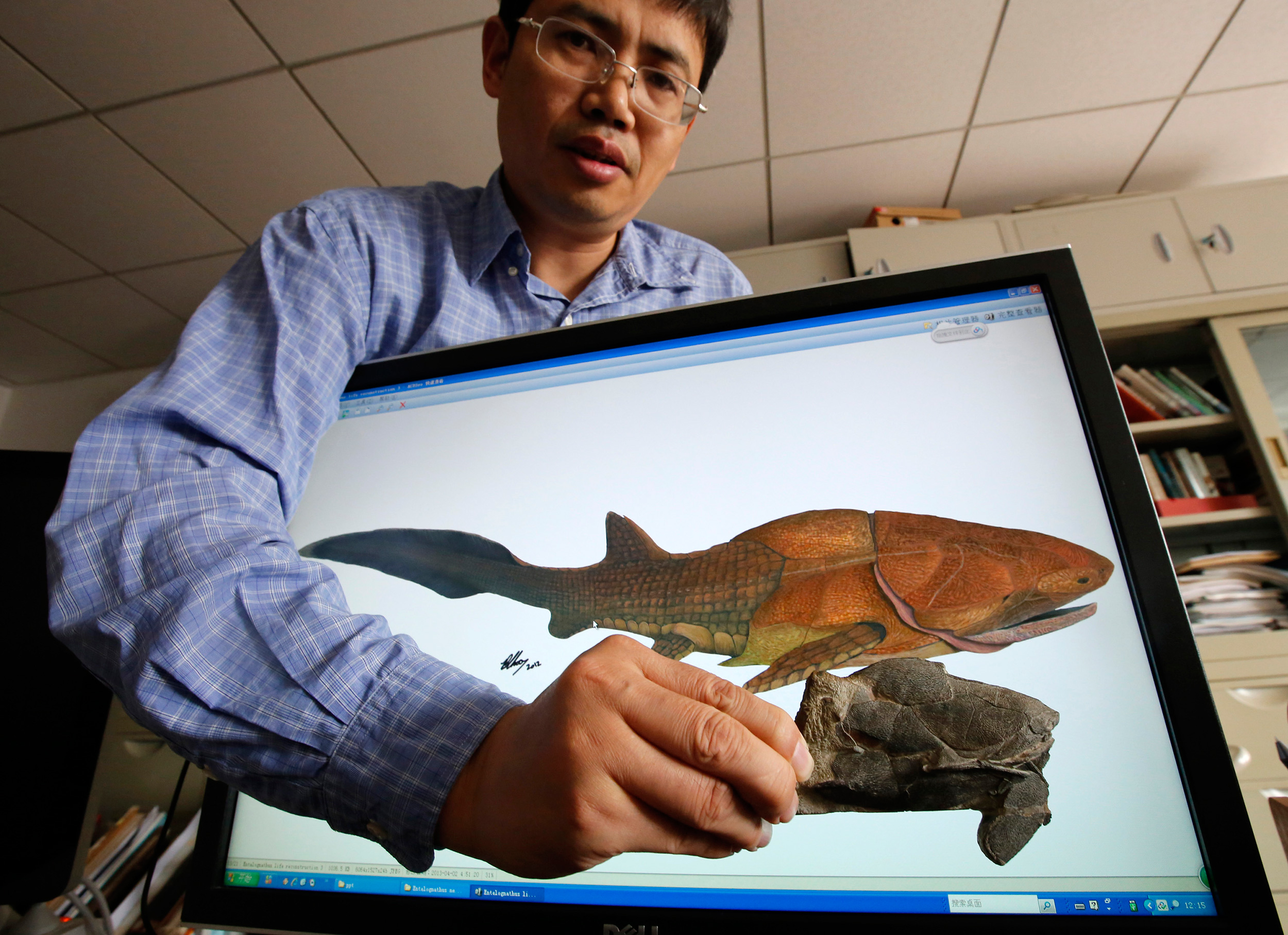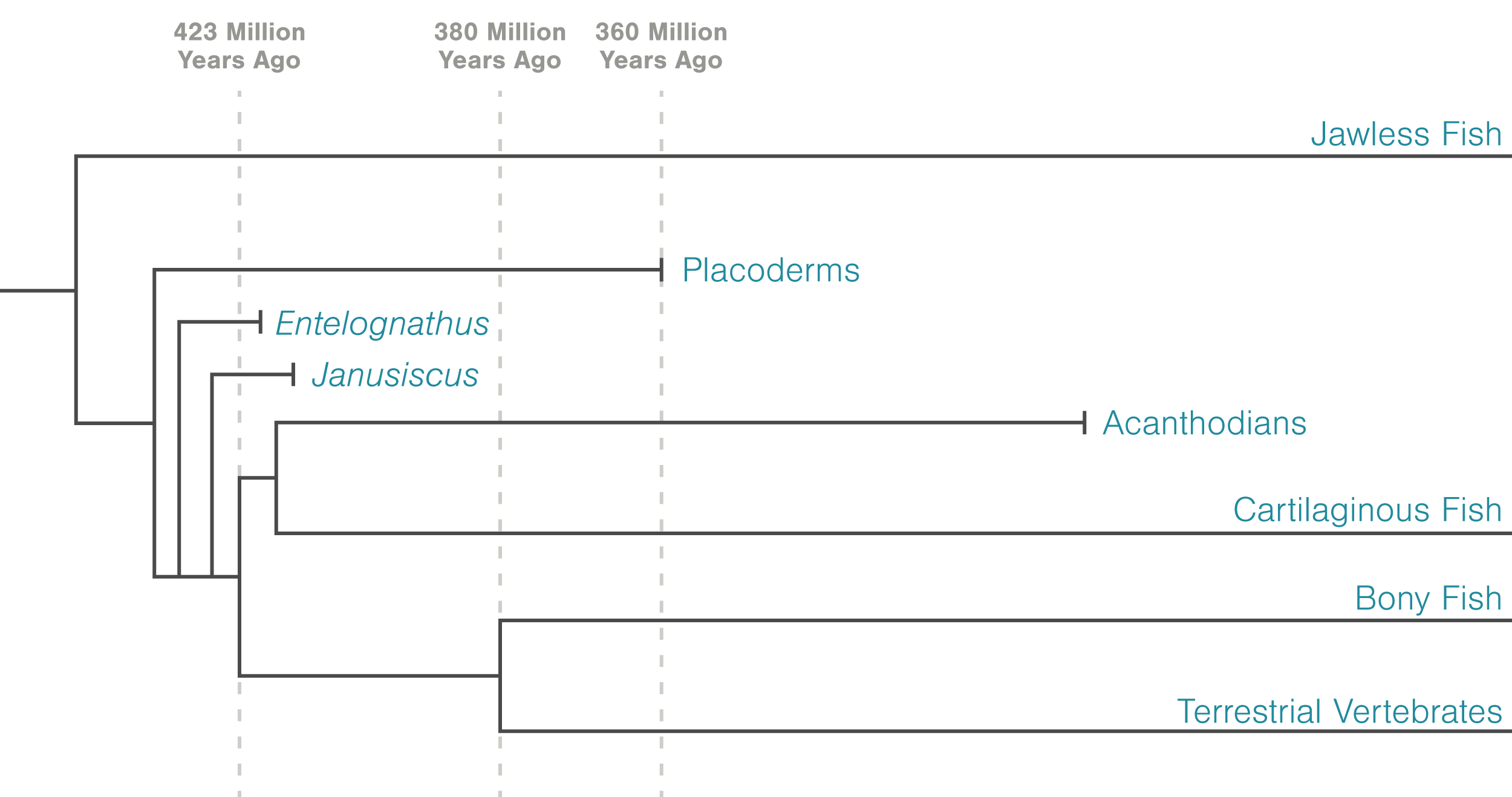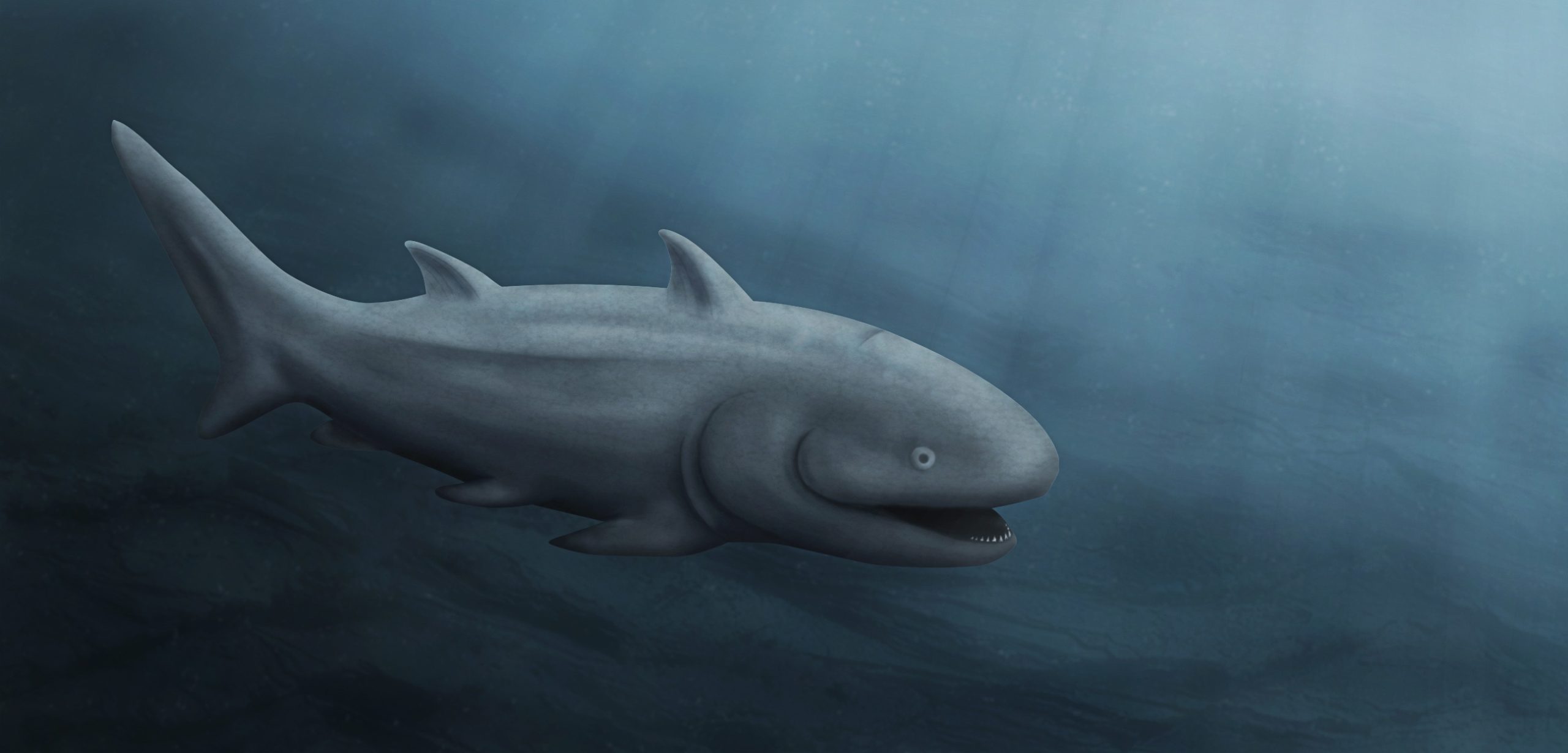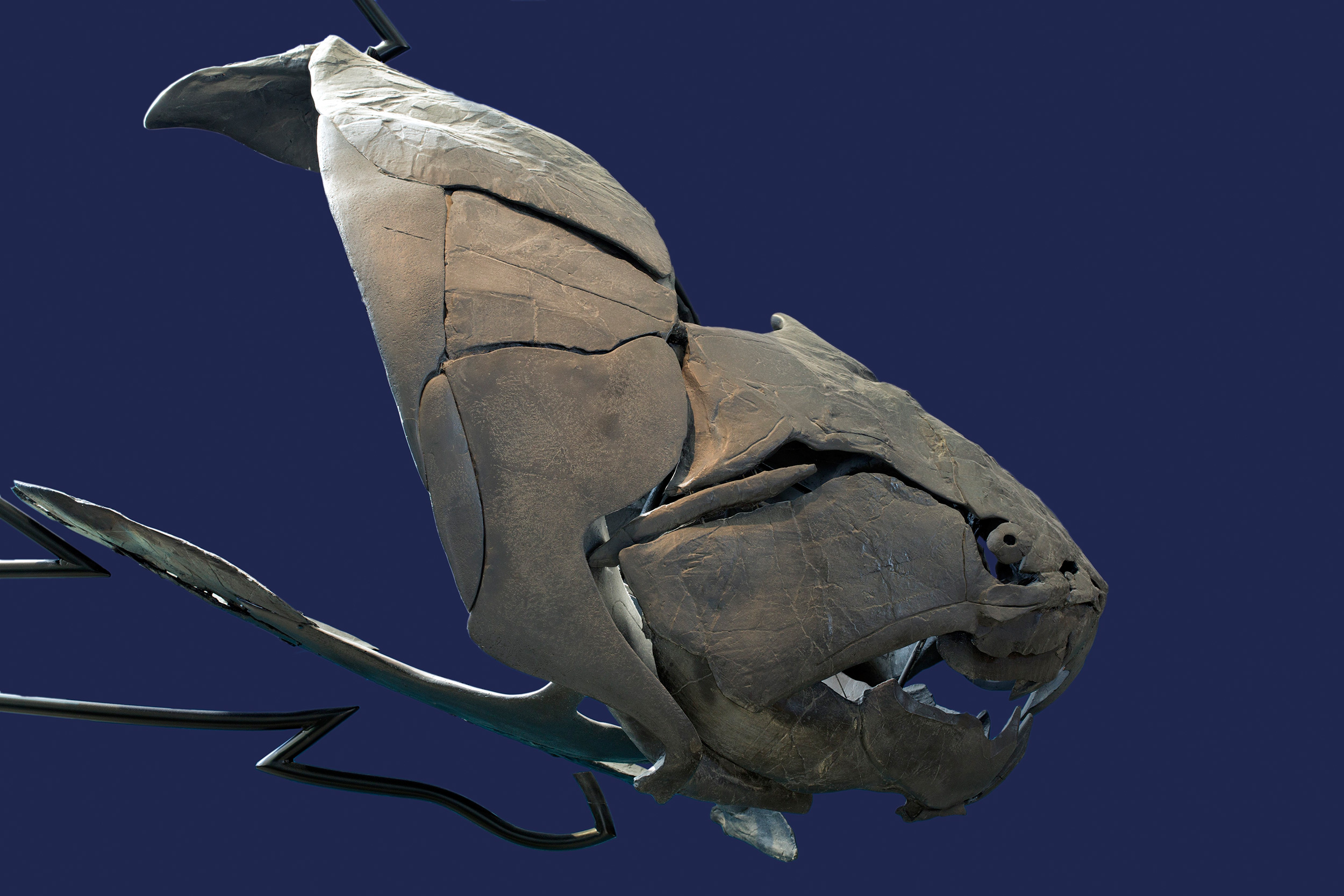Finding Our First Fish
Sharks aren’t primitive, and they aren’t the most primitive surviving jawed fish either. New fossils are rattling the fish family tree.
Article body copy
In 2012, Martin Brazeau was looking for fossils. But he wasn’t on his hands and knees, examining ancient rocks with a hammer, chisel, and brush. He sat at his desk at the Naturalis Biodiversity Centre in Leiden, the Netherlands, scouring the Internet.
Brazeau’s Google Images search struck virtual gold when he came across a high-resolution image of a fish’s skull, discovered in 1976 in rural Siberia and recently digitized and uploaded by the Institute of Geology at Tallinn University of Technology in Estonia. It was labeled Dialipina, a fish well known from 400-million-year-old rocks.
As a specialist in early fish evolution, Brazeau had teased histories from thousands of fossils, but this one was special. Where pieces of the skull roof had broken away, he could see the braincase underneath. It piqued his interest. Such a bony covering of the brain and the sensory organs within the head is a gold mine of information, giving invaluable insight into what the long-dead animal was like. Intrigued, Brazeau and his colleague Matt Friedman from the University of Oxford wanted more than just an image on their computers, so they requested the loan of the fossil from Tallinn. Within a few weeks it was on its way to Friedman’s office via special delivery.
After a cursory inspection, it would take more 21st century technology—this time CT scans that use high-powered X-rays to visualize the whole specimen, inside and out—to show that this fossil wasn’t Dialipina at all. It was a different kettle of fish. And it was about to shake up the story of fish evolution and the widely accepted hierarchy of life. More than just a case of mistaken identity, this fossil, eventually renamed Janusiscus, would help shed light on a central question of paleontology: what did the common ancestor of all jawed fish alive today look like? And, since every land-dwelling animal initially came from the water, this question concerns us all.
An animation showing the top of a 415 million-year-old Janusiscus fossil dissolving into a 3D model of how the fish’s skull might have looked. While the skull’s external features resemble bony fish, the interior of the skull includes structures reminiscent of cartilaginous fish such as sharks and rays. This fossil’s “two faces” is referenced in its name, Janusiscus, which comes from the Roman God, Janus, who is said to have two faces. Animation courtesy of the University of Oxford
Up until very recently, the prevailing description of this founding fish—the one that begat all jawed fish alive today—was guided more by 18th-century philosophy than 21st-century science. With scant evidence, it was held that this long-lost creature resembled a shark, with a skin covered in small tooth-like scales, a mouth filled with a conveyor belt of continuously renewing teeth, and spines reinforcing many of the fins. This idea was “deeply entrenched,” says Friedman. It was a hangover from the early days of paleontology and evolutionary theory when paleontologists were trying to piece together a hierarchy of life with “primitive” organisms on the bottom rungs and humans at the pinnacle, like the star atop a Christmas tree.
Historically, the research agenda was: figure out the narrative first and then find the fossils to fit it, explains Brazeau. And since sharks have some morphological features that extend far back in the fossil record, this line of thinking concluded that they were the ancestral blueprint for fish. There was the assumption that since sharks have many primitive characteristics, then all sharks are primitive, Brazeau explains, adding that many contemporary textbooks still portray this view. “That [interpretation] was attractive, it was convenient, it was a good story.”
But it’s a story that falls short, and textbooks are due for an update.
Over the last few years, Brazeau, Friedman, and a cadre of other paleontologists and ichthyologists—armed with new technologies able to peer deep inside fossils—are shining a torch into this deep, dark hole of evolutionary biology. Their method? Let the fossils—such as Janusiscus—do the talking.
When alive and with its head attached to the rest of its body, Janusiscus swam in the oceans about 415 million years ago, in the so-called Age of Fish. At this time—early in the Devonian Period—everything with a jaw was a fish. There were no amphibians, reptiles, mammals, or birds. It would still be some 30 million years before their terrestrial descendant would evolve, dragging themselves up from the water at about the same time that trees were first taking root.
Compared to the neatly categorized fauna we’re familiar with today, the Devonian ocean was an experimental melting pot of jaws, fins, tails, and spines. Placoderms, a group of heavily armored fish, dominated the Devonian seas, as evidenced by their ubiquitous and bountiful fossil record from rocks of this age. One could imagine these fish, with their casing of thick interlocking plates of bone, preparing for a great war in Fishdom, but they actually succumbed to one of the world’s “big five” mass extinction events at the end of this period, about 359 million years ago.
Swimming in the shadows of the placoderms were the fish that went on to become the forerunners of today’s two major fish groups: cartilaginous fish, the sharks and rays; and bony fish, a category that includes a stunning diversity of species, from S-shaped seahorses with prehensile tails to the lopsided leviathan that is the ocean sunfish.
But piecing together how we got from the ancient fish of the Devonian sea to the piscine diversity we see today is a fragmented tale with a lot of blank spaces. Early fossil records are meager and limited to a few isolated teeth or scales, a handful of skeletal fragments, and the occasional fish-shaped stain on a rock. Trying to piece together their evolutionary history was like navigating through a dark labyrinth, and paleontologists of yore got lost. In place of hard evidence, the image of the fish’s common ancestor was painted using a palette of presumptions.
A primary supposition was that a lack of bone equated to a lesser being. Seeing that sharks and their kin had cartilaginous skeletons, the anatomists of the 19th century placed them at the bottom of the fish family tree. This presumptive and ideological move relegated cartilaginous fish to this position for centuries. “It wasn’t founded on any well-formulated [evolutionary] argument,” says early vertebrate paleontologist Michael Coates from the University of Chicago. The assumptions were untested, but cartilaginous fish were stuck where they were pigeonholed. “It’s the legacy of pre-Darwinian ideas imported into an evolutionary worldview,” Coates says, referring to the outdated assumption that cartilage was simpler than bone and, by extension, sharks and their kin are simpler than bony fish and “lower” on the tree of life.
To a large extent, this presumption was reinforced when paleontologists looked to creatures alive today for clues into the deep past. Had they retained some vestiges of their ancestry? In all vertebrate embryos, for instance, skeletons are initially made of cartilage, which is then hardened—ossified—into bone in most animals. Cartilage comes first. Bone is an embryological afterthought. “Because of that kind of observation—that particular one, I think—an idea developed that sharks were representative of the ancestral condition,” says Per Ahlberg, a paleontologist from Uppsala University in Sweden.
“Given only modern data, it’s perhaps not unreasonable to think that [cartilaginous fish] are capturing a snapshot of some early stage of vertebrates figuring out how to mineralize their skeletons,” concedes Friedman. But when you look backward through this long telescope of time, the picture at the other end is always likely to be misleading. A lot can change over 400 million years.
And it can be appreciated with an Internet find.
Aged 36, with thin-rimmed glasses, hazel-colored facial hair—somewhere in between stubble and a beard—and accentual traces of his American past, Friedman looks like a rugged Edward Snowden. As professor of paleobiology at the University of Oxford, he focuses his research on revealing secrets of the fossil record, giving forgotten specimens a new lease on life, unearthing insights that paleontologists before him had missed or misinterpreted.
On his glass desk, just next to a series of 3D prints of fish skulls, is Janusiscus. At first glance, there’s not much to see. Contained within a small cardboard box, on a bed of white foam, the fossilized fragment is thumbnail-sized, the color of dark charcoal, and looks vaguely wrinkled like a prune.
But there’s more than meets the eye here, Friedman assures me. “Looking at the top of the skull, you get one view of what the creature is,” he says, while pointing at the top of the skull with his pinky finger. “[But] look at the other side: you get a very different feeling.” In this case, it’s what’s on the inside that counts.
For the best part of a year, Friedman’s PhD student at the time Sam Giles compared Janusiscus with 78 fossil fish of roughly the same age. They compared a catalogue of traits—the shape of the skull, the presence or absence of fissures, and the positions of nerve and blood canals—and entered their observations in a spreadsheet. Then their computer models took over, comparing similarities and dissimilarities to ascertain the most likely relationships and to determine where the species sat on the family tree.
Despite what Janusiscus’s bony skull roof suggests, the fish wasn’t a member of the bony fish family at all.
The researchers concluded that Janusiscus belonged to a branch of fish that reached back before the split between cartilaginous and bony fish. Its evolutionary line precedes the pivotal moment in evolution when cartilaginous fish went one way, and bony fish—and everything else—went the other. In other words, this ostensibly boring fossil is a rare glimpse into what the common ancestor of the two major fish groups alive today may have looked like. It’s not the ancestor, but it’s not that far away.
Janusiscus’s wrinkled skull roof is classic placoderm and bony fish. But inside, CT scans reveal the arteries of a cartilaginous fish and the sensory structures and nerves of a bony fish. Janusiscus is a mosaic, a mishmash of all three fish groups thrown into one fish.
The discovery of Janusiscus and its anatomical secrets is part of an evolving picture of what the “founding fish” might have looked like. “One fossil by itself doesn’t change everything,” Brazeau says.
But two fossils might.
Enter Entelognathus, a fossilized placoderm from 419 million years ago, making it about four million years older than Janusiscus. In 2013, research at the Chinese Academy of Sciences revealed that this hand-sized placoderm had the jaws of a bony fish, rather than the single scythe-like plate that is a characteristic of placoderms. Entelognathus—meaning “complete jaw”—had a jaw and cheeks comprising many different-sized bones, connected like a jigsaw puzzle. Put another way, this discovery means that bony fish likely inherited their jaws from placoderms, an evolutionary link that had evaded appreciation up until this point.
Seen this way, with Entelognathus as a possible steppingstone between placoderms and bony fish, our view of the common ancestor suddenly shifts, says Coates. “Imagining it as shark-like is a mistake.”
Even with the recent discoveries of Janusiscus and Entelognathus, fossil evidence is still in short supply. “We have to acknowledge the fact that there’s probably quite a lot of stuff [at this evolutionary junction] that we don’t yet have a handle on—that we don’t yet understand,” says Coates. “We ought to expect the unexpected.”

Min Zhu, from the Chinese Academy of Sciences, shows a fossil of the armored fish, Entelognathus, in front of a computerized rendition of how the fish might have appeared when it lived about 419 million years ago. Photo by Kim Kyung-Hoon/Reuters/Corbis
With more data, species can jump from one part of the family tree to another as new similarities are revealed. But the core branches are not likely to change. Entelognathus and Janusiscus have spoken. Their word isn’t final, but it’s closer to the truth.
Our view of sharks and their kin as being primitive, or ancestral, has been misplaced.
Deep in their history, they once had the ability to produce bone, and then they lost it. It mustn’t have suited their lifestyle. Instead they hardened their skeletons with a rind of toughened cartilage. They also shed their ancestral bony armor, replacing it with tiny tooth-like scales, known as dermal denticles. “We’re getting this repeated message,” says Coates. “We’re discovering just how specialized the modern sharks are.”
Yet the common ancestor of all fish alive today wasn’t a typical bony fish, either. As Janusiscus demonstrates, it was more likely to be an amalgam of features. “Both cartilaginous fishes and bony fishes have a lot to tell us about the last common ancestor, as they necessarily must,” Friedman explains. Like the inheritance between parent and offspring, both are bound to have a certain likeness to their predecessors.
Humans also share this ancestry. It is part of the story of how we came into being. Since all land-living, back-boned animals descend from a branch on the bony-fish tree, this evolutionary forebear binds every amphibian, reptile, bird, and mammal alive today. Trace the evolutionary roads of any of these vertebrates back far enough and you will come to a single shape: a fish that lived roughly 423 million years ago.

The fish family tree, showing the common ancestors of bony and cartilaginous fish as well as land-dwelling vertebrates. Illustration by Mark Garrison
Before I left his office, I asked Friedman to draw an updated version of this ancestral fish on my notepad. If it’s not like a shark, what did it look like? Based on the fossils that surround it in time, what features were likely to be present in this founding fish? I had read the studies and the descriptions, and seen some of the most recent fossils in print and in person, but I required a condensed 2D representation in front of me: a personal preview of what is to be expected for textbooks over the coming years.
“What, now?” Friedman asks.
“Yes, please. Just a quick sketch,” I say, appreciating that no one has ever asked him this before.
After an “Oof!” and a short pause for thought, he begins, commenting on each new feature as it takes shape underneath the ballpoint pen, omitting those parts that the fossil record has yet to part with. When he’s finished, he turns the notepad back toward me so that the fish’s two dorsal fins are pointing upward, its eyes facing to the left. In just under two minutes, Friedman has drawn something that scientists have been trying to picture for over two centuries.
In blue ink, the fish has a curved head like a Volkswagen Beetle’s hood, a covering of thick bony armor extending from the head to the shoulders, a long asymmetrical tail, and a spine attached to most of the fins. It’s an amalgamation like nothing alive today. It can’t be labeled by modern look-alikes. As I look at the drawing in front of me, over 400 million years of evolution stares back.
Correction: The original version of this article identified Matt Friedman as being at the Leiden University. It has been corrected to the Naturalis Biodiversity Centre in Leiden.


